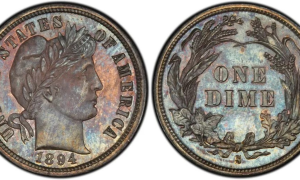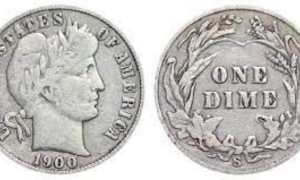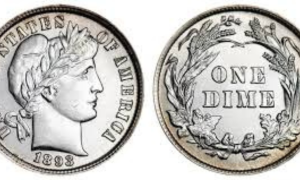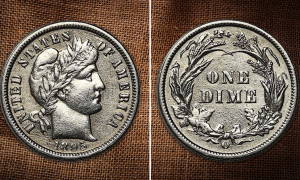The Barber dime, minted between 1892 and 1916, holds a special place in the hearts of numismatists and collectors alike. As one of the most significant coins of the late 19th and early 20th centuries, the Barber dime reflects the cultural and economic transformations of the Gilded Age and the early Art Deco period in the United States. While all Barber dimes contain intrinsic silver value, certain years are particularly sought after, with some fetching millions of dollars at auction. Here’s an in-depth look at what makes these coins so valuable.
A Brief History of the Barber Dime
The Barber dime was designed by Charles E. Barber, the Chief Engraver of the United States Mint. Along with the design for the quarter and half dollar, Barber’s dime debuted in 1892. Known for its classic and elegant design, the Barber dime features Lady Liberty in profile, wearing a Phrygian cap, with the inscription “Liberty” on her headband. The reverse side shows a wreath surrounding a large “DIME” inscription, flanked by “UNITED STATES OF AMERICA” and “E PLURIBUS UNUM.”
What Makes Barber Dimes Valuable?
Barber dimes are made from 90% silver, giving them inherent melt value, which means even dimes in worn condition are worth at least a few dollars. However, it’s the rarity and condition of certain years that make them highly collectible. Some Barber dimes are extremely difficult to find, especially in mint condition, which drives their value up significantly.
Most Valuable Barber Dimes
While there are numerous Barber dimes in circulation, some years are especially rare or collectible, making them worth thousands or even millions of dollars. Let’s take a closer look at the most valuable examples:
1. 1894-S Barber Dime Proof: $1,997,500

Among the most valuable coins in U.S. history, the 1894-S Barber dime proof is exceptionally rare. With estimates suggesting only around 24 were minted, and only 8 or 9 are known to survive, this coin is a true numismatic treasure. A well-preserved example sold for nearly $2 million at auction in 2016. The story behind the coin adds to its mystique: it’s said that Hallie Daggett, daughter of the San Francisco Mint Superintendent, was given a few of these dimes by her father, but one was spent on an ice cream cone, forever circulating as a “common” coin.
2. 1900 Barber Dime Proof: $66,000

Although not as valuable as the 1894-S proof, the 1900 Barber dime proof is still highly sought after, especially when it features a nice contrast between the coin’s design and its background. With a pristine example fetching $66,000 in 2020, collectors prize the beauty and quality of this coin. Proof coins, like this one, have superior strikes and shine compared to business strike dimes.
3. 1893-S Barber Dime: $63,250

The 1893-S Barber dime is another key date for collectors. Although it’s not a proof coin, its rarity, especially in an uncirculated state, makes it highly valuable. Known for its sharp design and quality of strike, an example of this coin sold for over $63,000 in 2007.
4. 1895-O Barber Dime: $58,755

The 1895-O Barber dime is one of the rarest coins due to the limited mintage from the New Orleans Mint. Many of these dimes were circulated in the South, making mint-state examples even harder to come by. In 2017, a mint-state version of this coin sold for almost $59,000.
5. 1895 Barber Dime: $46,000

Struck in Philadelphia, the 1895 Barber dime is rare with only 690,000 minted. Despite being less rare than the 1895-O, it’s still an important coin for collectors. A high-grade example of this coin sold for $46,000 in 2005, highlighting its desirability in the numismatic market.
Business Strikes vs. Proof Coins
A key factor in determining the value of a Barber dime is whether it’s a business strike or a proof coin. Business strike dimes were intended for general circulation and were made in large quantities. Proof coins, on the other hand, were struck with higher quality and used for collectors. These proofs are often shinier, with deeper, crisper strikes. Due to their superior craftsmanship, proof Barber dimes tend to be worth more than business strike versions.
1916 Barber Dime: Not a Rarity
While the Barber dime was widely circulated during its time, 1916 marks the end of its production. A new Mint Director sought to replace the Barber dime with a new design, but due to delays, the 1916 Barber dime was struck in large numbers, with over 18 million entering circulation. This makes the 1916 Barber dime less valuable and not a rarity.
Identifying Rare Barber Dimes in Your Collection
If you have Barber dimes in your collection, it’s worth checking for key dates such as 1893, 1894, and 1895. Mint-state dimes, especially those that have not seen much circulation, are more likely to fetch top dollar. Even if you don’t own one of the highly valuable rarities, it’s always a good idea to examine your Barber dimes for quality, as coins in pristine condition can be worth more than their counterparts in poor condition.
Conclusion
The Barber dime is a coin with deep historical significance, representing the prosperity and transformation of the United States at the turn of the 20th century. While many Barber dimes are worth only a few dollars due to their silver content, others, especially those from rare years or in mint condition, can fetch tens of thousands or even millions of dollars. Whether you’re a seasoned numismatist or a novice collector, the Barber dime is an excellent coin to seek out for its beauty, history, and potential value.



Leave a Reply